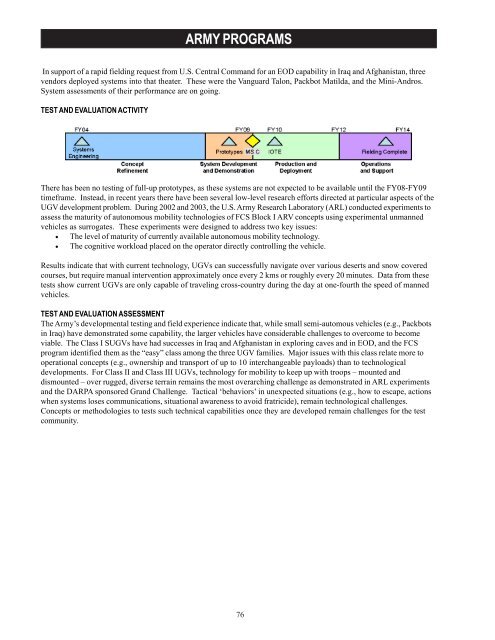Future Combat Systems Unmanned Ground Vehicles (UGVs)
Future Combat Systems Unmanned Ground Vehicles (UGVs)
Future Combat Systems Unmanned Ground Vehicles (UGVs)
Create successful ePaper yourself
Turn your PDF publications into a flip-book with our unique Google optimized e-Paper software.
ARMY PROGRAMS<br />
In support of a rapid fielding request from U.S. Central Command for an EOD capability in Iraq and Afghanistan, three<br />
vendors deployed systems into that theater. These were the Vanguard Talon, Packbot Matilda, and the Mini-Andros.<br />
System assessments of their performance are on going.<br />
TEST AND EVALUATION ACTIVITY<br />
There has been no testing of full-up prototypes, as these systems are not expected to be available until the FY08-FY09<br />
timeframe. Instead, in recent years there have been several low-level research efforts directed at particular aspects of the<br />
UGV development problem. During 2002 and 2003, the U.S. Army Research Laboratory (ARL) conducted experiments to<br />
assess the maturity of autonomous mobility technologies of FCS Block I ARV concepts using experimental unmanned<br />
vehicles as surrogates. These experiments were designed to address two key issues:<br />
• The level of maturity of currently available autonomous mobility technology.<br />
• The cognitive workload placed on the operator directly controlling the vehicle.<br />
Results indicate that with current technology, <strong>UGVs</strong> can successfully navigate over various deserts and snow covered<br />
courses, but require manual intervention approximately once every 2 kms or roughly every 20 minutes. Data from these<br />
tests show current <strong>UGVs</strong> are only capable of traveling cross-country during the day at one-fourth the speed of manned<br />
vehicles.<br />
TEST AND EVALUATION ASSESSMENT<br />
The Army’s developmental testing and field experience indicate that, while small semi-automous vehicles (e.g., Packbots<br />
in Iraq) have demonstrated some capability, the larger vehicles have considerable challenges to overcome to become<br />
viable. The Class I S<strong>UGVs</strong> have had successes in Iraq and Afghanistan in exploring caves and in EOD, and the FCS<br />
program identified them as the “easy” class among the three UGV families. Major issues with this class relate more to<br />
operational concepts (e.g., ownership and transport of up to 10 interchangeable payloads) than to technological<br />
developments. For Class II and Class III <strong>UGVs</strong>, technology for mobility to keep up with troops – mounted and<br />
dismounted – over rugged, diverse terrain remains the most overarching challenge as demonstrated in ARL experiments<br />
and the DARPA sponsored Grand Challenge. Tactical ‘behaviors’ in unexpected situations (e.g., how to escape, actions<br />
when systems loses communications, situational awareness to avoid fratricide), remain technological challenges.<br />
Concepts or methodologies to tests such technical capabilities once they are developed remain challenges for the test<br />
community.<br />
76

















